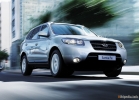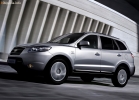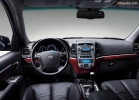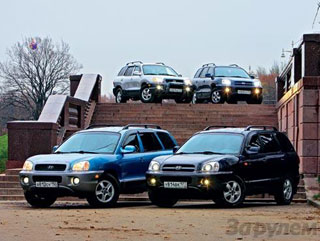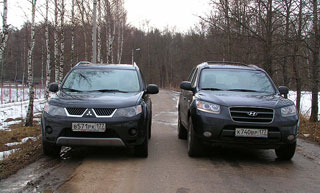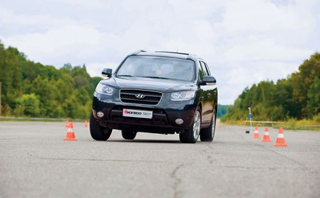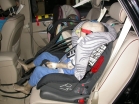Hyundai Santa Fe 2006 test drive - 2009 SUV
Three "Korean" served
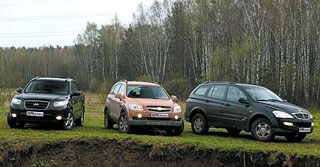 Today's heroes of our heading are true Koreans
Today's heroes of our heading are true Koreans And let the readers not bother the golden cross on the Chevrolet Captiva grille assembled near St. Petersburg: the car was created by Daewoo Motor specialists, only then becoming GM DAT. Yes, and Ssangyong Kyron was not born on the shores of the Kama. Well, Hyundai Santa Fe is completely a real Korean from Ulsan. Although there was a car with an eye on America.
We will not devote much to the description of the appearance of our heroes. We note only the exterior of the Chevrolet Captiva: thanks to the muscular arches and overlays made of unpainted plastic, the crossover looks quite in combat. In the guise of Hyundai Santa Fe there is no hint of a tendency to exploits on off -road. And the only car in our Trinity today, at least some kind of claiming the title of real SUV, Ssangyong Kyron is completely like a minivan. Take a look at the soft abrose of the body with heavily littered front racks, large slanting headlights
However, let's look at the salons. You will find leather chairs with electric drives of settings, of course, only in top versions. In the base fabric. Driving places are allowed both to the commander’s landing (high and close to the steering wheel), and relaxed, relaxed for SUVs. The seats and steering column adjustments are quite large. Kyron and Santa Fe trunks are regulated only by inclination and relatively small limits. Koreans are read without problems. But the classic set of scales is designed differently. For example, Captiva dials floating on each other soothe the eyes with a pleasant greenish backlight, the Santa Fe shield irritates, like an obsessive neon sign. And only deprived of the additional aesthetic load Kyron devices are neutral and most informative as possible.
Three adults are placed in the rear sofas. And together there are no problems at all: the legs for the legs are in abundance even for a very tall driver, and the feet easily fit under a high pillow of the front chair. True, high passengers will feel a lack of air above the head in a hat in any of the three Koreans cannot be sat. But if desired, the back of the seat can be thrown back and travel reclining.
Unlike the twin brother, Opel Antara, the Chevrolet crossover allows the installation of the third row of seats (and even non-childish even an adult with a tall of 180 cm does not propagate the ceiling). Therefore, the trunk here is very voluminous.
If you fold the seats of the second row, it seems that you can also push the elephant (and the tilted back of the front seat significantly facilitates the transportation of long -meters) in the captiva salon). Note that it is very convenient to load a large -sized lug on a perfectly even low platform. Well, with small things, it’s easier: it is not necessary to open the large fifth door to raise the rear window. The fifth door of Santa Fe rises only the whole. However, in terms of the volume of the luggage compartment, Hyundai, also designed by seven -seater, almost does not lose to the competitor. The rear seat folds to the level of the trunk floor, forming an impressive size of the cargo site or, if you like, a berth.
Having folded the sofa Kyron, you will not get a perfectly flat floor remains a barely noticeable threshold. However, the compartment is almost as capacious as the opponents, and the covered niches in the floor and the walls of the trunk are also available here
Well, the salons of our heroes are quite spacious and comfortable. What are they on the go? Depending on temperament and financial capabilities, the future owner of Captiva can choose one of two gasoline engines with a working volume of 2.4 and 3.2 liters developing 136 and 230 horsepower, respectively. As a transmission, a 5-speed mechanics or (for a surcharge) machine with the same number of gears is proposed. Hurricane dynamics is a rather heavy Captiva with a basic power unit (not to mention the version with a machine gun) is not happy. This is especially acutely perceived against the background of Santa Fe, available with us only with a 2.7-liter 189-horsepower V6 and ICP-5 or ACP-4. But the comparison with the 150-horsepower Kyron 2.3 AT-4 CHEVROLT crossover can withstand almost equal. By the way, Ssangyong can be purchased not only with gasoline, but also with a diesel 2-liter 141-horsepower engine. Both motors are aggregated both with a mechanical and automatic gearbox, and a 5-speed machine gun has a 5-speed.
Be that as it may, our heroes go differently, but everyone is not bad. From the point of view of acoustic comfort, there were no big claims to Koreans. So, according to trifles: the engines at high speeds are noisy, it would not hurt to isolate the wheel arches better. But aerodynamic noise even at very high speeds is almost inaudible. And the smoothness of the course as a whole is worthy of praise. Captiva and Kyron are especially good in this regard. But Santa Fe pendants are more tough.
And what about handling? Captiva responds to the steering wheel with a noticeable lazy. However, information content in most cases is enough. Only with sharp maneuvers does the car show a noticeable tendency to skidding, which, however, is effectively extinguished by a stabilization system. But the direct crossover holds remarkably, almost without regard to the quality of the road surface.
The Santa Fe steering wheel is more than the reactive effect in almost all modes. Moreover, sensitivity with speed increases, but does not become excessive. As a result, Hyundai clearly stands on the straight line, with maneuvers no delay, minimum rolls and a steering wheel poured. A supporting body with high indicators of angular stiffness, and an independent suspension of all wheels provide this rather large crossover almost light handling.
It is quite decent for a heavy, almost two -ton, frame SUV with an uncertain rear axle on the road and Kyron. The steering accuracy here, of course, is noticeably lower than that of the rivals, and the rolls are higher in corners.
However, on a straight car holds very confidently, and in skillful hands it turns out to be very maneuverable.
In general, in the city stream, the driver of Ssangyong will definitely not feel damage. And on the off -road and even more so. Outside the asphalt, Kyron will easily give a head start not only to crossovers. An impressive road clearance, relatively small base and overhangs provide this Korean with good geometric cross -country ability. In an off -road arsenal, a rigidly connected front bridge, reducing gear and a self -locking differential of the rear axle (option).
Of the off -road arsenal, at the disposal of the Hyundai driver, only the possibility of forced blocking of a multi -disc electromagnetic coupling in the rear wheels drive. Chevrolet does not have this. It is impossible to forcefully block a similar coupling, independently connecting the rear wheels when slipping the front ones.
In fact, the only tool activated directly by the steering wheel is the descent control system: the button with a characteristic icon is located on the central console. These machines do not have inter -long locks: crossovers can withstand diagonal hanging only due to the suspension. Therefore, it is better to overcome a more or less serious obstacle like snow virgin grounds, sandy dunes or wet clay (it’s even better not to meddle on a suspicious area at all). He stopped sat down. To slip and swing the car, trying to rescue it from captivity, it is especially not worth it: you get burnt even more. And most importantly, in about twenty desperate struggle, you risk overheating of the very multi -term coupling and completely lose all -wheel drive. At least until it cools down
So, each of the heroes of our heading is attractive in its own way. Due to the specific design, Ssangyong feels more confident in the off -road. We would call Hyundai the hero of the asphalt. And from the point of view of utilitarianism, Chevrolet leads. After all, only Captiva is offered in us in a seven -seater design.
The last argument in the dispute, as usual, will be money. Captiva 2.4 LS with four airbags, ESP, air conditioning, CD/MP3 Magical Magnetic, Parkertic and heated electric grinders cost $ 29,990. Supplement for automatic transmission and luggage seats $ 2200.
A little more expensive ($ 31,400) will cost Kyron 2.3 Original C ABS, two airbags, air conditioning, heated seats, a full electric packet. The version with automatic transmission, climate control, light and rain sensors cost $ 4000 more.
For Santa Fe GL (six airbags, air conditioning, heating the front seats, electric mirrors) they ask for $ 36,990. For automatic transmission, climate control and heating of mirrors, $ 3100 must be paid.
Chevrolet Captiva crash test
Crash tests according to the EURONCAP method was subjected to the basic captiva without side pillows. The car performed well: the pedal and steering wheel are normal, but the front panel is recognized as traumatic. When hitting the pillar of Captiva, one point was missing: the curtain of security was not completely opened. In total 31 points, or 4 stars. Not everything is smooth and with the protection of passengers-children (3 stars out of 5) during the front dough, their chest cells experienced increased loads. Experts appreciated the pedestrian rating at 2 stars of 4: the edge of the hood is too tough.
Ssangyong Kyron crash test
It is reliably known that solid international organizations like EURONCAP or NHTSA Ssangyong Kyron crash tests (as, indeed, other models of this manufacturer) did not conduct. In the absence of an authoritative opinion, we take a chance to assume that the means of active and passive safety (in the ABS database, front pillows, belts with pretense) will be enough to preserve the life and health of the driver and passengers of the Korean SUV. And we will go to the build quality, of course.
Hyundai Santa Fe Crash Test
In testing according to the EURONCAP method, the crossover proved to be good. Experts estimated a high level of protection, but stuck on a potentially dangerous front panel, also noting the brake pedal shifting back almost 100 mm. With a lateral blow, the car was fined one point for incompletely open safety curtains. As a result, 29 points, or 4 stars.
With children's safety, Santa Fe is a little better than Captiva, 37 points against 36 (3 stars). But for pedestrians, Hyundai, who has not scored a single score, is deadly.
Chevrolet Captiva
+ A powerful engine, a comfortable salon, a roomy trunk.
- slippery pushing seats, an inconvenient handbrake, bad on the off -road.
Ssangyong Kyron
+ On the makings, a real SUV, relatively low price.
- Supporte buttons on the steering wheel, exterior design for an amateur.
Hyundai Santa Fe
+ A good ratio of price and quality, good dynamics, a spacious interior.
- Pretty voracious with a small volume of the tank, scabbard instead of a handbrake.
Andrey Tsybulsky
Photo author: Armen Meetarjyan
A source: MKOMBILA magazine [May/2008]
Hyundai Santa Fe 2006 Krash Video - 2009
Hyundai Santa Fe 2006 test drives - 2009
Hyundai Santa Fe 2006 Krash Test - 2009
Krassh Test: Detailed Information29%
Driver and passengers
36%
Children-passengers


